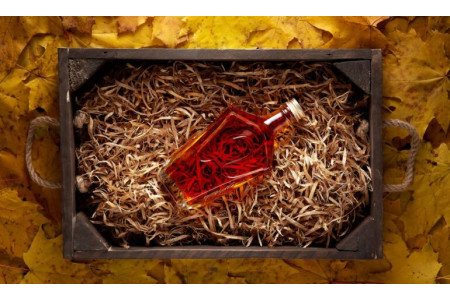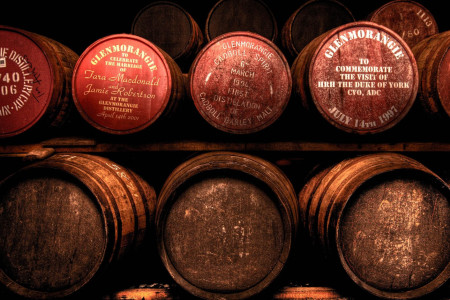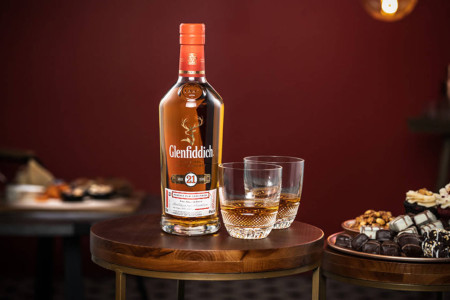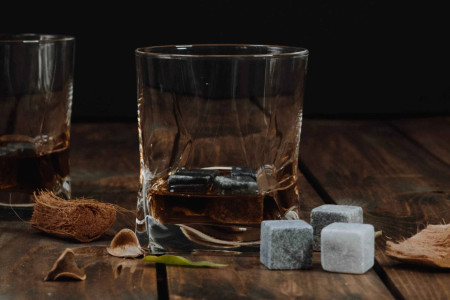THE BEST TASTING SCOTCHES FOR BEGINNERS – A COMPLETE GUIDE

It’s a high-quality alcohol perfected through years of fine-tuning that’s only produced in one country – Scotland. Yet, for the beginner, it’s not always easy to find the subtle beauties hidden in a fine scotch. In this article, we’ll guide on some of the best tasting scotch for beginners.
Scotch is a complex spirit made from barley that may or not be smoked over a peat fire. This gives the whisky its characteristic smoky flavour. Regarding the , you might want to look for a scotch that combines notes of caramel, vanilla, and oak with fruity or spicy undertones. This combination of flavours will impart the best qualities of scotch and create a truly delicious tasting experience.
If you’re first dipping your toes into the wonderful world of scotch whiskies, take time to find a spirit that speaks to your taste buds. In this guide, we’ll walk you through the variety of different scotch whiskies and help you understand what makes this spirit unique from other types of whisky.
What is Scotch and how is it made?
Before heading to the best tasting scotch for beginners, it is important to know what you are drinking.
Scotch is a type of whisky and, like any other, it’s made from a distillation of grain alcohols. With other types of whisky, the distiller may use a blend of barley, wheat, rye, or corn, but with scotch, it’s always made from a blend of barley grains.
The grains are soaked in a vat for two to three days in a process known as malting. Once thoroughly soaked, they’re drained and laid out to germinate. Once spouted, the grains are then dried over a peat fire (although this kind of fire is not a mandatory step) and mashed into a powder called grist. Grist is then mixed with hot water to extract the natural sugars in the barley, transforming it into wort.
The wort is mixed with yeast and allowed to ferment into a beer-like beverage over a 2-day period. Once enough of the natural sugars have transformed into alcohol, the distiller heats the mixture in a pot still until the vapours rise and are carried away into a separate pan. The liquid is distilled two or even three times until it becomes a raw liquor.
To improve the flavour of the liquor, distillers store and age the scotch in oak casks until it takes on the complex and rich flavours we associate with a fine scotch whisky. Once properly aged, the spirit is packaged into bottles, sealed, and delivered to your nearest store.
3 factors that make scotch truly unique
This process is quite similar to other types of whisky, but scotch is unique in a few ways:
The process of drying malted barley over a peat fire imparts a rich and smoky flavour you won’t find in other whiskies.
Unlike bourbon, which is made almost entirely from corn or rye mash scotch whisky is made almost entirely from barley.
Scotch must be produced and bottled entirely in Scotland. The term “scotch” is a registered geographical indication, meaning that any product made outside the registered scotch-producing localities cannot legally be called scotch whisky.
Other than these differences, scotch has a particular flavour that no other type of whisky can capture. You’ll know it when you taste it and it’s hard not to love.
5 Different Types of Scotch Whisky
As if the wide variety of whiskies didn’t make it complicated enough, there are actually several different types of Scotch whisky even within the small geographical region of Scotland. Each style has its own unique flavour profile, and you may enjoy one over another. Take a minute to read about each and try them all if you get the chance.
Highland Scotch Whisky
The highland region is the largest of the scotch-producing areas in Scotland. The climate is cooler and the terrain more rugged than the lowlands, allowing for a longer growing season. Therefore, the barley has more time to mature and develop a more complex flavour.
Highland scotch is characterized by a heathery, earthy flavour with hints of peat and smoke. The best highland scotch whiskies are full-bodied with a long finish and often have a rugged and distinct spice on the front pallet. They are often considered the gold standard for a good single malt scotch but lack the eccentricities of other regions. The best tasting scotch for beginners will likely be from this region of Scotland, but we’ll provide you several options from several regions.
Speyside Scotch Whisky
Speyside is a small region located within the highlands. The climate is milder than the rest of the highlands and the terrain is gentler, with rolling hills and green meadows. This means the barley has an even longer growing season and matures more slowly, resulting in a sweeter flavour.
Speyside scotch is characterized by a sweet, fruity flavour with hints of honey and vanilla. The best Speyside scotch whiskies are smooth and mellow with a short finish. Many beginners will prefer this style of scotch thanks to its gentle sweetness and notes of stone fruit and flowers.
Islay Scotch Whisky
Islay (pronounced ee-lay) is a small island off the coast of Scotland. The climate is cool and damp with strong ocean winds and the terrain is rocky and covered with peat bogs. Due to these conditions, the barley grows slowly and matures even more slowly, resulting in a strong, distinct flavour.
Thanks to the abundance of peat across the island, Islay distillers are not afraid to fire their malt barley. Islay scotch is famous for its strong, peaty flavor with hints of salt and seaweed. The best Islay scotch whiskies are full-bodied with a long finish that coats the tongue and back pallet.
Lowland Scotch Whisky
The lowland region is the southernmost of the scotch-producing areas in Scotland. The climate is milder than the highlands and the terrain is gentler, with rolling hills and green pastures. The barley has a shorter growing season due to warmer temperatures and matures more quickly, resulting in a lighter flavor.
Compared to all other scotch whiskies, lowland scotch is characterized by a light, grassy flavor with hints of floral and citrus. The best Lowland scotch whiskies are light and refreshing with a short finish and make wonderful mixers or can be enjoyed over ice on a warm day.
Campbeltown Scotch Whisky
Last but not least, we have Campbeltown scotch. This region was once the largest producer of scotch whisky but today only three distilleries remain. The climate is mild and the terrain is rolling hills with green valleys, similar to the lowlands. Thanks to its warmer climate, the short growing season results in a lighter flavor.
Much like lowland scotch, Campbeltown scotch is characterized by a light, grassy flavor but with stronger notes of peat. The region is closer to the ocean than the lowlands and, therefore, has a slightly earthier and sea-breezy flavor than you’ll find in the lowlands.
Smoothness Over Flavour? What to Choose?
Just because a scotch whisky taste amazing doesn’t mean you’re destined to fall in love with it. If you are new to the world of scotch, you may be put off by the high alcohol content that comes with the territory. After all, most scotch whiskies contain between 40 and 60 percent alcohol. If you’re crossing over from beers or wines, that’s a big leap.
Understandably, then, you’ll want to find a scotch that’s relatively smooth, or even the best tasting scotch for beginners, which is your case. Beware that smoothness refers to the strength of the alcoholic bite left on the tongue; not necessarily how much alcohol is in the scotch. Luckily, there are plenty of options available with a standard (or even higher-than-average) amount of alcohol that won’t leave your mouth feeling singed.
In fact, as far as whiskies go, scotch is one of the smoothest. This is thanks to the long maturation process required to produce a viable scotch. Most commercially available scotch whiskies are aged for no less than 10 years in oak casks. Some are then aged for an additional 2 or more years in sherry, bourbon, or other casks.
As a rule of thumb, the older the scotch, the smoother it will be. That’s not to say that younger scotches can’t be smooth, but they will likely have more of a bite. When it comes to smoothness, then, it’s a matter of finding a scotch that’s been aged in the right type of cask and for the right amount of time.
We recommend experimenting with a variety of options, including those we’ve shared above, to find the perfect balance between flavour and smoothness. Be aware, though, that as whisky ages, the flavours change, and you may even discover subtleties within a single distillery from one batch to the next.
The best tasting Scotch for Beginners – Where to Start with So Much Variety?
So, now that you have a basic understanding of how scotch is made and the range of distilleries dotted across Scotland, you’re probably wondering where to begin. It can seem overwhelming at first but we’re here to guide you through some of the best scotches for beginners.
You don’t need a professional pallet to enjoy these spirits and can find them at most liquor stores near you.
Johnnie Walker Black – The Top Seller
Johnnie Walker Black is an iconic and longstanding leader in the world of scotch whiskies. It also happens to be the best-selling scotch in the world, making it a likely contender for most people’s first foray into scotch. Regarding an inexpensive scotch for beginners, this is great expression to go.
After carefully explaining the different scotch regions, you’re probably wondering which category Johnnie Walker falls into. We hate to break it to you but it is a blend of several different whiskies sourced from across Scotland. This includes more than 29 different spirits taken from the high and lowlands, Speyside region, and Islay Island.
Many highbrow scotch connoisseurs turn their noses to blended whiskies but we’re here to tell you that there’s absolutely nothing wrong with a blend, especially when you’re first exploring the range of options. In fact, blended whiskies are specifically made to create a delicious, palatable spirit that takes the best qualities from the top distilleries in Scotland.
Johnnie Walker Black is rich in caramel and toffee flavours with a gentle fruitiness on the back pallet. It’s almost like drinking a smokier version of cake. It’s sure to welcome you into the world of scotch and prime you for single malts later in your journey.
Glenlivet 12 Year – A Path Towards Single Malts
The next step on your scotch whisky journey is to start exploring single malts. These scotches are made entirely from one distillery and, as the name suggests, are usually aged for a minimum of 12 years. This particular scotch comes from the Glenlivet distillery located in the Speyside region of Scotland and we consider it to be one of the best tasting scotch for beginners.
As we’ve mentioned, Speyside scotches are known for their clear, bright, fruity flavors and Glenlivet 12 Year is no exception. That’s one of the reasons why Glenlivet 12 Years is one of the best single malt scotch for the money.
On the nose, you’ll pick up strong notes of pears, apples, and other orchard fruits paired with a hint of honey. The taste is light and sweet with a touch of vanilla that mellows into the sweet grassiness of a graham cracker.
The finish is short but delightful, leaving you wanting more. As far as we’re concerned, this particular scotch is a great gateway into the world of single malts. It’s light, sweet, and easy to drink, making it a perfect choice for beginners, and will prepare you for the more intense, punchier flavors of an Islay or Campbelltown scotch.
Balvenie 14 Year – A Step Up from the Glenlivet 12 Year
The Balvenie 14 Year is another great choice for those just getting into scotch whisky. Like the Glenlivet, it’s a single malt from the Speyside region and, therefore, shares many of the same characteristics. You can expect the clarity of a Speyside, as well as the light fruitiness and honey afternotes that make these scotches so delicious.
The Balvenie, however, is aged in two types of casks. The first is a traditional oak cask, which imparts the scotch with its characteristic sweetness. The second is a sherry cask, which adds a layer of rich fruitiness to the spirit. This makes it bolder and richer than a standard Glenlivet 12 Year and a nice upgrade to what’s often seen as the gold-standard single malt.
On the nose, you’ll find a rich creaminess tinged with toffee and brown sugar. The taste is sweet with vanilla and the fruitiness of mango and citrus towards the back pallet. The finish continues strong with more vanilla and ends with a nice balance of black pepper. Overall, the flavor coats the mouth and leaves a fruity flavor reminiscent of expensive jam.
Since the Balvenie 14 is slightly bolder than the Glenlivet 12, some beginners may take time to warm up to its punchier flavor but, thanks to its sweeter and fruitier composition, it’s sure to be a hit no matter who you are.
Macallan 12 Year – The Perfect Introduction to Highland Scotch
The Macallan 12 Year is a single malt scotch whisky from the Highland region of Scotland. Unlike the Balvenie and Glenlivet, which are both light and sweet, the Macallan is rich and full-bodied with a strong flavor profile.
On the nose, you’ll pick up strong notes of oak and citrus with a hint of honey. The taste is rich and complex with more oak, as well as a touch of spice (very characteristic of a highland scotch!). The finish is long and lingering, leaving your pallet soaked in a peppery smokiness.
This particular scotch is a great choice for those who want to explore the more robust flavors of scotch whisky and it’s an excellent introduction to the oomph of highland scotches. Macallan 12 Year is rich, full-bodied, and perfect for sipping on a cold winter’s night, or pair it with blue cheese and a steak for an unforgettable tasting experience.
Laphroaig 10 Year – A Powerful and Complex Islay Whisky
Last but not least, we have the Laphroaig 10 Year, a single malt scotch whisky from the Islay region of Scotland and one of the best tasting scotch for beginners who think might like a smoky dram. As we’ve mentioned, Islay scotches are known for their strong, peaty flavors and this one is no different.
On the nose, you’ll pick up strong notes of peat and smoke with a hint of sea breeze. The taste is bold and peaty with more smoke and a touch of salt. The finish is long and lingering, leaving you with the taste of barbecue and bread. While this may not be for everyone, Laphroaig 10 Year is a longstanding favorite among Islay lovers.
This particular scotch is the best place to start as you explore Islay whiskies. The Islay region is distinct and hard to compare to highland or lowland scotches. For those who enjoy its peatiness, though, nothing beats this style. Laphroaig 10 Year is a great choice for those who want to explore the region thanks to its rich, full-bodied, and complete profile.
What to Try After Getting Your Wings?
After taste-testing your way through the standard beginner scotches, you’ll want to move to more complex options that can open your pallet to a world of opportunities. You may be tempted to jump straight to the most expensive scotch you can find but the price doesn’t always mean you’re getting the best batch around.
Instead, we recommend researching the best tasting scotch for beginners and connoisseurs. Start upgrading to older, more mature options, for starters. For our top pick, we recommend Bunnahabhain 25 Year Old. This well-aged spirit comes from the Islay islands and was named the 2021 “Taste Master” at the Scotch Whisky Masters Awards.
Although Islay whiskies are best known for their strong smoky flavor, the Bunnahabhain 25 Year Old has matured into a unique and complex profile of roasted nuts, leather, sea brine, and dark caramel. This is thanks, in part, to the sherry casks that they transfer the scotch into after 10 years in oak.
Bunnahabhain 25 Year Old isn’t a scotch for the novice drinker, though. With a price tag of around $400, it’s an investment in quality and something best reserved for special occasions and close friends. Bring it out for the holidays and enjoy its subtle, rich qualities when the time demands it.
The Bottom Line
If you’re setting out on a journey to discover scotch whiskies, you may not know where to start. We recommend Johnnie Walker Black as a primer before you dive into single malt and regional varieties. From there, explore Speyside and the lowlands with a Glenlivet or a Balvenie before heading to the highlands with a Macallan. Finally, unearth the peaty richness of Islay with a Laphroaig.
Soon enough, you’ll have a well-rounded pallet that’s ready to taste any scotch, no matter how mature it may be!





